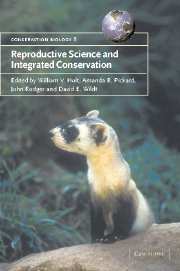Book contents
- Frontmatter
- Contents
- List of contributors
- Foreword
- Part I Introduction
- Part II Reproduction and population viability
- Part III Reproductive techniques for conservation management
- Part IV Integrated conservation management
- 14 Integrating reproductive sciences into recovery programmes for declining and extinct marsupial populations
- 15 Captive breeding and predator control: a successful strategy for conservation in Western Australia
- 16 Black-footed ferret: model for assisted reproductive technologies contributing to in situ conservation
- 17 Genetic resource banks for species conservation
- 18 Fertility control for wildlife
- 19 Contraceptive vaccine development
- 20 Field applications of fertility control for wildlife management
- Part V Reproduction science in non-mammalian species
- Part VI Conclusions
- Index
- References
20 - Field applications of fertility control for wildlife management
Published online by Cambridge University Press: 21 January 2010
- Frontmatter
- Contents
- List of contributors
- Foreword
- Part I Introduction
- Part II Reproduction and population viability
- Part III Reproductive techniques for conservation management
- Part IV Integrated conservation management
- 14 Integrating reproductive sciences into recovery programmes for declining and extinct marsupial populations
- 15 Captive breeding and predator control: a successful strategy for conservation in Western Australia
- 16 Black-footed ferret: model for assisted reproductive technologies contributing to in situ conservation
- 17 Genetic resource banks for species conservation
- 18 Fertility control for wildlife
- 19 Contraceptive vaccine development
- 20 Field applications of fertility control for wildlife management
- Part V Reproduction science in non-mammalian species
- Part VI Conclusions
- Index
- References
Summary
INTRODUCTION AND OBJECTIVES
Reducing fertility, as opposed to increasing mortality, is an increasingly accepted approach to managing wildlife problems. New immunologically-based approaches (immunocontraception) are often coupled with new technologies for delivery, some of which involve biotechnology (Rodger, 1999). This has created an interesting situation where there is often public support for fertility control for ethical reasons but strong antipathy to genetic engineering (Fitzgerald et al., 2000).
Significant progress has been made with the technical aspects of contraceptive vaccine development for wildlife management (Mate & Hinds, Chapter 19). The development and application of such vaccines, however, require that biotechnology runs in parallel with ecological, behavioural and modelling studies so that criteria established for successful applications in the field help define vaccine and delivery system design and efficacy targets (Sinclair 1997).
Equally, important political and societal concerns about these new approaches need to be considered right from the start. The potential use of transmissible delivery systems, such as genetically modified viruses, also raises international concerns about the risk of natural or illegal spread (Williams, 1997).
This chapter provides an overview of recent pen and field studies and modelling exercises to define the criteria for successful application of immunologically-based fertility control and the likely outcome of deployment of this technology. The chapter focuses on management of key mammal pests in three regions – house mouse, rabbit and fox in Australia, brushtail possum in New Zealand and white-tailed deer in North America. The first four species are introduced, the last is indigenous.
- Type
- Chapter
- Information
- Reproductive Science and Integrated Conservation , pp. 305 - 318Publisher: Cambridge University PressPrint publication year: 2002
References
- 4
- Cited by



